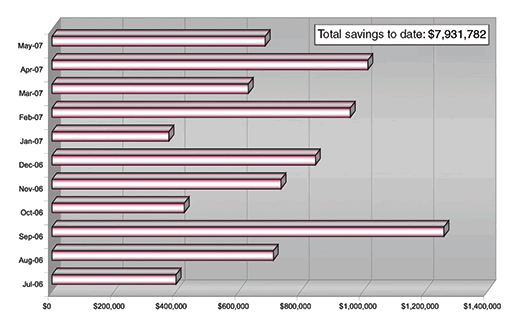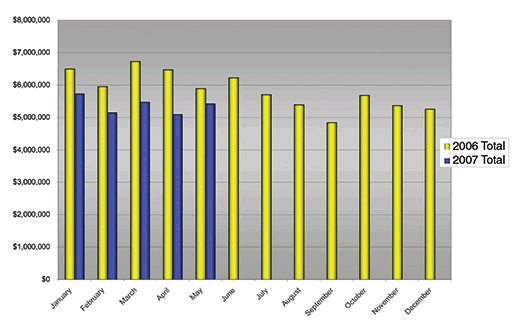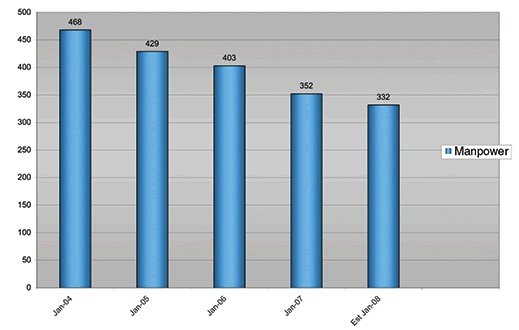

"We didn't know how good we could be until TDG worked with us. TDG helped us define the direction we needed to travel and understand the results we needed to achieve to be truly better."
Below is our featured article from Pulp & Paper magazine - Novemember 2007 by Joseph Noble
How Longview Fibre Company used an outside resource to transform its Maintenance Group into a world-class operation...and reduced costs by millions annually
November 2007 By Joseph Noble
Finding efficiencies and productivity where none or little was thought possible is a perpetual charge of executives and their labor union counterparts. Maintenance departments are being called upon to scrape out significant cost reductions. To find those reductions, they are shifting from a reactive maintenance philosophy to a predictive philosophy that improves machine reliability, increases productivity, initiates planning strategies, and demands performance accountability. Maintenance departments, in other words, have entered an era of tough, emotional transformation to help their companies compete.
Maintenance is a key function for any manufacturer; repairs can disrupt an entire process and even halt production. In 2004, Longview Fibre Company exemplified a business in need of change to compete in an increasingly competitive market. While its challenge may seem familiar to many manufacturers, its response reduced costs by millions of dollars annually and dramatically improved maintenance operations and machine reliability.
Located in Longview, WA, the company produces a broad range of paper and container board products at one of the world's largest papermaking complexes. Set on 357 acres and "constructed in record time in 1927," according to the December 1927 issue of Pacific Pulp & Paper Industry magazine, it now has capacity to produce more than 3,300 tons/day of paper/container products. It operates eight paper machines, nine batch digesters, and loads approximately 22 railcars and 90 trucks of product per day. Besides the mill, the operation includes an onsite box plant producing up to 17 tons/hr of corrugated board. The Longview operation is large and complex, with nearly a century of culture and business processes — not all of them competitive in the 21st Century marketplace.
A Look Back
Despite years of significant capital investment, Longview found itself in a difficult situation. Due to influences out of its control, it experienced a monthly cash flow swing of $3.5 million. In addition, global competition, and rising wages and health care costs compelled leadership to begin a company-wide transformation of the business.
Longview's Maintenance Group was a primary target because it had low productivity and marginal performance (as exemplified in its four divisions that defended their turf and communicated only when necessary). It had inadequate reliability of repairs (as seen in its reactive, "just fix it" philosophy). Its costs were rising (it was Longview's biggest cost to production after raw materials). It was also a primary target for change because of its importance to production.
Finally, the Maintenance Group was ill-equipped to plan, schedule, account for and achieve the maintenance needs of the plant on a consistent, day-to-day basis. They had almost no data about costs, which were divided by production groups and did not reckon for financial oversight. It was not possible to analyze what costs were, who was spending what money or what effect maintenance had on a machine and production.
"There was no planning at all," explains Rocky McCulloch, currently a senior planner in the maintenance organization. "One group wouldn't talk with another; our unions wouldn't talk with supervisors; we had no accountability or metrics; and a new computer system required first line supervisors to spend five hours per day entering data instead of being on the floor with their crews. Maintenance work was unreliable and few appreciated the true cost of this activity."
Longview completed several change analyses and ideas were discussed. From the ideas, they established goals: They wanted to become a predictive, reliable, cost-conscious maintenance department.
Initially, leadership determined the Maintenance Group could transform through steady employee attrition. It employed 489 mechanics and figured it needed far fewer. Eventually, however, they realized that they needed more than just attrition to achieve their goals.
As much as management and employees wanted to change, they couldn't repair their department. The biggest impediment to change was their lack of self-confidence to succeed. As a culture, they didn't believe and trust they could change.
"It's like being stuck," says Dick Martinson, maintenance superintendent (retired). "We knew what we needed to do, but just couldn't get it done. Belief that we could change, was missing"
Longview needed an outside resource that could expedite and add to the changes already started. Martinson called on Terry Whalen and his Team Development Group (TDG). Martinson and Whalen had met more than 30 years ago when Whalen first consulted with Longview management, and they kept in touch over the years. "In hindsight, we should have brought Terry in five years earlier," Martinson said. "It's always best to get a solution in place before the problem becomes so bad."
A Complete Transformation
Since 1980, TDG has assisted major corporations in a dozen industries in developing business and operations processes that improve competitiveness and cost controls, and deliver measurable results. TDG conducts needs analyses, implements strategy, and provides continuous hands-on process support, in effect, rolling up their sleeves and getting dirty to get real results.
Founded and run by Whalen, TDG was asked to assist Longview in transforming its Maintenance Group. From May 2004 to February 2007, TDG facilitated the dramatic change process that has led Longview's Maintenance Group down the road towards world class status, and secured millions in annual cost reductions.
Building on Longview's established goals for change, TDG identified five basic objectives of their work. First was to reduce costs. This would be realized in a number of ways. Second, create a more disciplined approach to maintenance, including planning, scheduling, policies, procedures and CCMS. Third, foster communication, coordination and cooperation between maintenance and operations. Fourth, develop first and second line leadership. Fifth and finally, increase the involvement of hourly personnel and improve communication between the workforce and leadership.
"TDG promised us improved machine reliability, reduced costs and 20% in maintenance attrition," recalls Longview's VP of manufacturing services, Bob Pollock. "I liked that, a lot."
"We needed to change the culture and help the Maintenance Group with applying the changes," adds Whalen. "We worked with them hand-in-hand to make the changes stick. They had to change their mental attitude — they focused on what they couldn't do, and we needed them to focus on what they could do, on the possibilities."
In the Beginning...
To begin the large transformation process, Whalen and TDG colleague Don Reynolds interviewed all managers and supervisors, and more than 120 of the 1,150 hourly, unionized workers. They had three goals for the interviews: first to clarify maintenance problems; second, to identify opportunities for change; third, to begin building trust with the union and management.
At the start of the interviews, hourly workers expressed frustration and anger. But eventually, as they came to trust Whalen and Reynolds, valuable information emerged. As is often the case, the people closest to the work have valuable insights relevant to its improvement, and so it was at Longview.
As meetings with union workers continued, the TDG team kept union leaders abreast of its observations. This promoted open, constructive communications with union leaders, and cultivated a sense of individual importance to the process.
"It was important to hear the mechanics' opinions, insights, ideas for improvements, and yes, even their frustrations and pessimisms," says TDG's Reynolds. "The strategy also included working directly with union leaders because we needed the unions on board."
"Union partnership is everything," says the current maintenance superintendent, Bruce Warrick: "We all have to be successful together. TDG is the reason we have a productive relationship with our unions today."
The Outline for Change
Armed with information gleaned from the interviews, the next step for TDG was to create a design team made up of representatives from every department in the company. The design team was given broad authority to change how maintenance operated and how it was structured, answerable only to a steering committee of executives that, in the end, would approve every design team recommendation.
"We were told to make changes — to redefine and reorganize our department," McCulloch recalls, "but no one told us what changes to make or even what direction to go. It was up to us."
Facilitated by TDG, the design team created the outline for transformation, making sweeping recommendations to initiate change to achieve maintenance goals, and leading the process internally. It had to come up with a maintenance department that could provide reliability to equipment used in production and operations, not just fix problems.
The design team had to create a department that could plan and schedule maintenance on day-to-day, weekly, monthly and annual basis. It had to realign mechanic/ supervisor relationships, and even rewrite job descriptions. It had to train maintenance teams to become cross-functional and improve their access to resources. Finally, it had to make sure all the change resulted in cost reductions.
The cornerstone for change came in the form of planning and scheduling. Putting planners in place, training them and implementing work scheduling was key to becoming a predictive, strategic partner with production.
The process developed requires production to select the work projects and maintenance to plan and complete them. Job plans, which are guidelines and standards for completing the work, are used to facilitate consistency and accountability. (Job plans are being developed for every maintenance project in the mill.) Parts and equipment are tagged for specific job requests. Workers pick up each tag on their way to the jobsite.
"Before planning was implemented, a typical shutdown was 24 to 36 hours," says McCulloch. "Now, because of planning and scheduling, a shutdown takes 12-15 hours. Our volume of work is greater with fewer people. Work output has increased while man hours have gone down."
Next, the design team built work teams around those strategic positions, and began a process to make the teams cross-functional. The Maintenance Group went from four divisions to three, while productivity increased. Mechanics answer directly to production when on site, and both are required to provide feedback for the purpose of continuous improvement.
By June of 2005, people were trained and in place, 10% attrition had been achieved and whispers about constructive changes were heard at the executive level. Longview executives, such as CEO Rick Wollenberg and mill manager Rick Parker received the beginnings of positive feedback.
The first sign of results surfaced in the form of changes in communication. Mechanics and their supervisors, unions and management were starting to talk and trust each other.
Another sign was an increase in maintenance orders. Increased productivity allowed maintenance to accomplish far more work requests with fewer employees. The increase in maintenance work caused a (nearly 10%) rise in maintenance spending, much to management's chagrin. But its concerns were assuaged when TDG explained the spike was due to an increase in completed projects (i.e., mechanics were more productive and getting more work completed, which increased their use of materials and parts, due to planning and scheduling efficiencies), and the new level of spending was probably a more accurate reflection of actual maintenance costs at Longview (i.e., if maintenance had completed all the needed work, then it would have had to spend that amount).
TDG predicted that spending would begin to decrease as the Maintenance Group continued to streamline and implement productivity enhancements throughout maintenance operations. And that, while more and more maintenance projects would be completed, costs would continue to drop far below pre-spike levels.
"The initial rise in maintenance costs were a direct result of rising department productivity, with an immature planning process," explains Whalen. "We knew the changes just needed more time; but we realized that outside resources were not being managed effectively. So we implemented cost containment measures that we knew would further reduce maintenance costs."
Figure 1 - Savings compared with $6.1 million (2005-2006 average per month)
Cost Containment
Outsourcing maintenance is a common cost control approach throughout American industry including the pulp and paper industry. For instance, according to Pulp & Paper's annual mill manager survey, of all mill functions, mill managers outsourced maintenance work most often, despite also feeling that in-house maintenance is essential to reliability.
To be effective, however, outsourcing requires disciplined planning, detailed financial oversight, open communications and clearly defined leadership — all underdeveloped processes at Longview at the time. Longview's expenditures on outside resources turned out to be the most significant problem in cost overruns.
"Basically, anything anyone needed to get done and didn't wish to do internally, was hired out with almost no planning and cost oversight," says TDG's Reynolds. "Tracking costs was confusing and couldn't be calculated for budget comparisons. In essence, final cost was not a consideration when using contractors."
"Managing outside resources was key to controlling maintenance costs," says Martinson. "I estimated we were spending almost twice what we needed to on outside resources."
To respond, TDG's Reyolds and manufacturing services VP Pollock developed a series of cost containment measures that forced the Maintenance Group to comprehensively budget its costs, accurately account for its spending, efficiently manage its expenses, and fully report on how its work affects the company and the machines it maintains.
The cost containment measures turned out to be a critical step in the overall transformation. Spending was made transparent and maintenance and production were held accountable. Departments were forced to prioritize and coupled with maturing planning and scheduling functions, the cost containment effort resulted in dramatic spending reductions.
Kept on a series of spreadsheets, the containment measures gave Pollock and maintenance superintendent Warrick the tools they needed to hold the line on maintenance spending. Within months, maintenance achieved a dramatic 50% reduction in outside contractor use, totaling a near $1 million per month (average) in direct savings, as shown in Figure 1.
"The cost containment measures allow us to make good purchasing decisions," says Warrick. "They are one of the metrics against which we measure maintenance's performance today."
"The cost containment measures have definitely worked," adds Wollenberg.
Figure 2 - Maintenance department total spending summary
Lasting Results
Indeed, within a year, maintenance spending was dropping; within 16 months it was below 2004 levels and continues to drop. Maintenance spending for 2008 will approach a 20% reduction from the 2005-2006 levels. And this productivity gain is with fewer mechanics, improved completion rates, dramatically higher reliability with fewer people and better communication and coordination.
For example, the Longview mill used to undergo two maintenance shutdowns per year. Today, due to maintenance's transformation, it undergoes only one shutdown per year. That alone saves it more than $700,000 annually, according to Wollenberg.
Longview Fibre now does the same maintenance workload with 30% fewer mechanics (468 in January 2004 and 332 [estimated] in January 2008, as shown in Figure 3), achieving this in only three years without layoffs. And the dramatic reduction in onsite contractor spending confirms that the work was not simply transferred to others.
Labor relations have improved dramatically; supervisors communicate often with workers and workers regularly work across maintenance departmental divisions with few problems.
Finally, the changes and the processes that brought them about have been infectious. Some members of the design team have implemented changes with their employees in other departments.
The Longview Maintenance Group transformation from a reactive, expensive, unresponsive department, to a predictive, cost-conscious, reliable internal partner with a communicative and cooperative culture, exemplifies what can be accomplished when a manufacturer desires to change, and utilizes effective outside resources to facilitate the conversion.
Figure 3 - Longview Fibre maintenance department manpower summary 
Final Perspectives
"This experience has been good for us," says Wollenberg. "Maintenance and operations are working as a team to achieve higher machine reliability, better predictive maintenance, lower maintenance costs and higher productivity with a smaller maintenance force."
"Labor relations have changed considerably," adds Parker. "We were stuck in our old papermaking culture of us against them. We realized we needed to work as a team. TDG took the initiative to bridge that gap."
"TDG's approach is to get close to the people and help them through the transition," says Pollock. "That impresses me because it's about the people and helping them be more productive."
"TDG gave us methodologies for planning, provided coordination and leadership, and showed us the path forward," says Warrick. "They have the facilitation expertise to go about changing a company or department of this size. Further, TDG provides personnel with opportunities to go beyond their current professional standing, to grow and be noticed. In doing so, the process not only develops people professionally, it drives deep into everyone's ownership of the change process."
Summary
"This isn't some change du jour," says Whalen. "Longview Fibre's Maintenance Group knew what they needed to do to transform, they just didn't know how to make it work. With TDG's hands-on efforts, Longview reduced costs by millions of dollars annually, and is now compared as a world-class operation. TDG is a special kind of outside resource that can go into difficult circumstances and achieve transformational results."
Joseph Noble, is with Noble Communications. For more information about TDG, contact Team Development Group: 561-310-6511 - TWhalen@teamdevelopmentmn.com